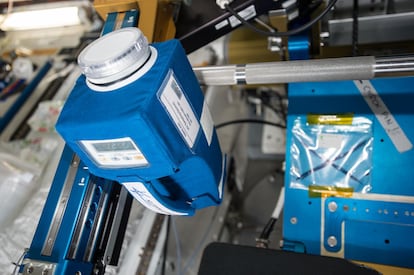If we ever find ourselves living off Earth, we’ll bring other species with us—for example, animals and plants to feed on. But we will also be accompanied by a host of uninvited escapees: bacteria, fungi and other microorganisms. What will happen to these microbes in extraterrestrial environments remains a mystery. For years, research has used the International Space Station (ISS) as a testing ground to study the effects of space on these tiny creatures. And what they’re discovering is, to say the least, disturbing: some microbes are becoming more dangerous.
The history of microbes in space dates back a long time: scientists began sending microorganisms into the atmosphere in stratospheric balloons in 1935. Unmanned satellites and orbital and lunar missions followed. The ISS has served as a microbial laboratory for its quarter-century existence. In 2006, a team of researchers led by Arizona State University sent cultures of the bacterium Salmonella typhimurium – known to cause food poisoning in cases of spoiled mayonnaise or undercooked tortillas – on the space shuttle Atlantis. The scientists found that “spaceflight samples exhibited increased virulence,” as they explained the following year in the journal PNAS.
By analyzing what made these space bacteria more infectious than their cousins on Earth, the researchers found the culprit: a protein called Hfq, whose change affected 73 other proteins. The scientists confirmed in ground simulations that the microgravity of space reduces the friction of the liquid medium with the bacteria, creating conditions similar to those when bacteria infect a host organism.
Salmonella became more infectious because it thought it was in the gut. As project leader Cheryl Nickerson said at the time, the bacteria “are smart: they respond to an environmental signal they see during the natural course of an infection.” Nickerson and her colleagues found that this effect could be neutralized by changing the composition of the medium.
The microbiome of the ISS
The problem is infinitely more complex. On the one hand, microgravity is only one of the factors in the space environment that affects microbes. Another is the high radiation levels compared to Earth. In addition, experiments such as Nickerson’s are performed under controlled conditions on cultured bacteria. However, since humans carry millions of microbes with them, they have also made the ISS their home.
Since 2015, NASA’s Microbial Tracking project began cataloging the station’s microbiome, discovering about 20 disease-causing bacteria. The research was then expanded to include the microbes present within the crew and to study mutations that could potentially increase the virulence of these microorganisms.

In addition to NASA, other space agencies involved in the ISS have undertaken their own projects. BioRisk and TEST, from the Russian space agency Roscosmos, have analyzed microbes and their genetic changes on the station’s surfaces, also finding surface bacteria that may have been transported from the atmosphere, or on spacecraft. The Japanese agency JAXA examined the bacterial and fungal populations.
Research has found that skin microbes are prevalent on the space station, especially staphylococcal bacteria and Malassezia mushrooms. Additionally, astronauts’ microbiomes have been found to change during their stay on the ISS, with other, less common microorganisms beginning to proliferate. Undoubtedly, the most surprising finding from various studies is that microbes adapt to life in space, becoming more aggressive: they tend to form biofilms: masses of cells bound together by a protective mucus-like substance and also develop resistance to antibiotics.
In 2018, some antibiotic-resistant strains of Enterobacter bugandensis were discovered in ISS, a bacterium first described in 2011 in a maternity hospital in Tanzania, where it caused severe neonatal infections. Scientists have been monitoring the evolution of these microbes to prevent them from threatening the health of astronauts. In 2024, researchers from NASA’s microbial tracking program and the Indian Institute of Technology Madras (IIT) analyzed 13 of these strains, finding that the station’s stressful conditions favored the spread of the mutants. “Microbes continue to baffle us by growing under the most challenging conditions,” said project co-director Karthik Raman, of IIT Madras.
Extreme Survivors
The study identified key genes and possible molecular mechanisms that make these bacteria more virulent in space, with the help of other microbes. “Our research reveals microbial community interactions how some benign microorganisms help to adapt and survive the opportunistic human pathogen, E. bugandensis, in the adverse conditions of the International Space Station,” said Kasthuri Venkateswaran, co-director of the study at NASA.
Venkateswaran and his team examined five newly discovered bacterial species found on the ISS and compared their genomes to their closest Earth-based relatives. They found a consistent pattern: space microbes exhibit adaptations to microgravity and improved DNA repair mechanisms to combat radiation exposure. While the pathogenic potential of these species remains uncertain, the observed mutations could potentially increase their virulence by enabling them to form biofilms and evade the immune system.
According to Venkateswaran, these findings could help design countermeasures against opportunistic pathogens. However, the consequences extend far beyond the astronauts’ health. If humans ever do embark on interplanetary travel, as envisioned by aerospace pioneer Konstantin Tsiolkovsky, a key question arises: How will we deal with the challenge of microbial contamination? Solutions like Boeing’s antimicrobial coating, now being tested on the ISS, aim to prevent space missions from inadvertently encouraging superbugs that could—for space colonists—potentially be a real extraterrestrial threat.
Register for our weekly newsletter to get more English-language news coverage from EL PAÍS USA Edition
